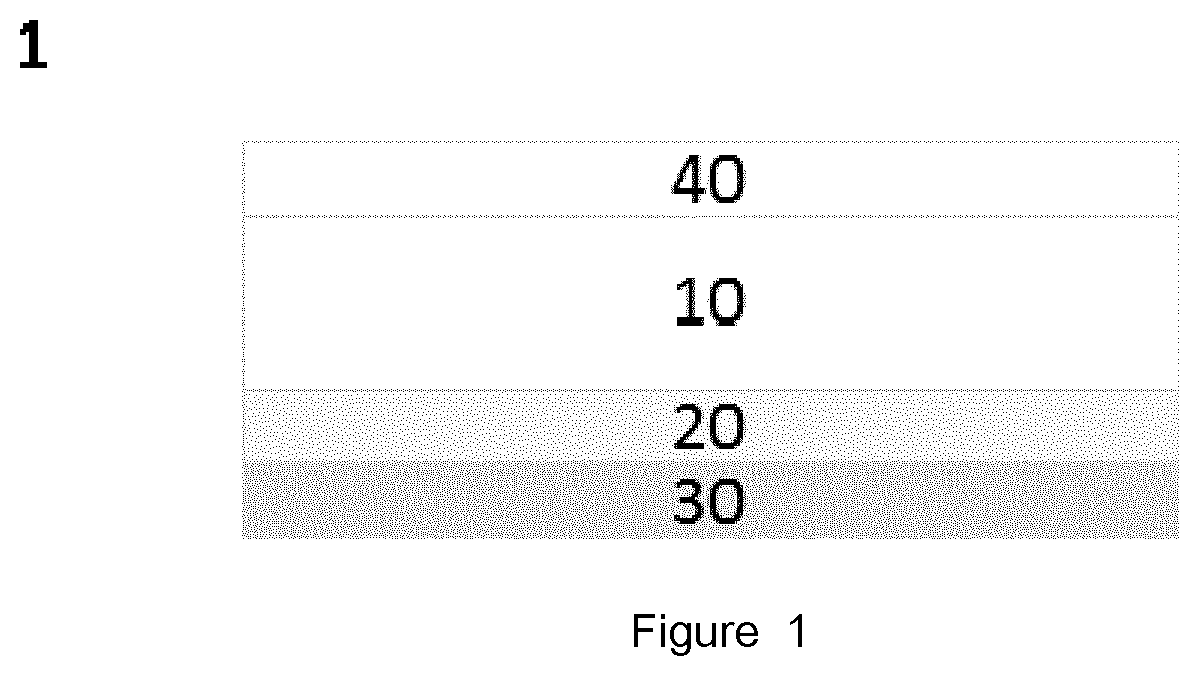Laser Markable Label and Tag
a laser markable and label technology, applied in the direction of identification means, thermography, instruments, etc., can solve the problems of unreadable laser markable information, complex manufacturing methods, and multiple layers, and achieve the effects of improving physical properties such as flexibility, scratch resistance, abrasion resistance and weatherability
- Summary
- Abstract
- Description
- Claims
- Application Information
AI Technical Summary
Benefits of technology
Problems solved by technology
Method used
Image
Examples
example 1
[0124]This examples illustrates the effect of the TiO2 amount on the laser marking properties of a white biaxially stretched polyester (BOPET) film.
[0125]ca. 1100 μm thick extrudates with a composition given in Table 1 were biaxially stretched according to the conditions given in Table 2 to provide a white biaxially stretched polyester film having a thickness of ca. 150 μm.
TABLE 1Ingredient (wt %)EX-01EX-02EX-03EX-04EX-05PET-012726252423PET-025049484746SAN15════CB-010.0025════OB-010.036════Ti022 4 6 810EX-06EX-07EX-08EX-09EX-10PET-012225232523PET-024548464846SAN15════CB-010.0025════OB-010.036════Ti0212————BaSO4— 610——CaCO3——— 610
TABLE 2Longitudinal StretchTransversal stretchRatioForce (N)RatioTemp (° C.)Stretching speed (% / min)3.363.2140-1452000
[0126]After biaxially stretched film was then subjected to a thermofixation step during 30 seconds at 235-240° C. air temperature.
[0127]The obtained white biaxially stretched polyester films (PF-01 to PF-10) were laser marked as described abo...
example 2
[0131]This examples illustrates the influence of longitudinal stretching parameters on the laser marking properties of a biaxially stretched polyester film.
[0132]A ca. 1100 μm thick extrudate with a composition given in Table 4 was longitudinally stretched using different stretching forces (LD SF) as given in Table 5 followed by transversal stretching at the conditions of Table 2 to provide a white biaxially stretched polyester film having a thickness of ca. 150 μm.
[0133]After biaxially stretching, the film was subjected to a thermofixation step at a temperature of 235-240° C. air temperature during 30 seconds.
TABLE 4PET-01PET-02SANTi02CB-01EX-1133501560.0025
[0134]The obtained white biaxially stretched polyester film (PF-11) was laser marked as described above.
[0135]The laser markings were evaluated as described above. The results are given in Table 5.
TABLE 5LD SF (N)Contrast4Too brittle50.7760.7470.7180.67
[0136]From the results in Table 5 it is clear that the Longitudinal Stretchin...
example 3
[0138]This examples illustrates the influence of thermofixation on the laser marking properties of a biaxially stretched polyester film.
[0139]Extrudate EX-11 (see example 2) was biaxially stretched using different stretching forces (LD SF) as given in Table 6 followed by transversal stretching at the conditions of Table 2 to provide a white biaxially stretched polyester film having a thickness of ca. 150 μm.
[0140]After biaxially stretching, the films were subjected to a thermofixation step as shown in Table 6 resulting in the biaxially stretched polyester films PF-12 to PF-17.
[0141]The obtained biaxially stretched polyester films PF-12 to PF-17 were laser marked as described above.
[0142]The laser markings were evaluated as described above. The results are given in Table 6.
TABLE 6ThermofixationLD SFT (° C.) filmTime (sec)ContrastPF-126——0.54PF-136165300.65PF-14200300.75PF-15215300.78PF-168——0.62PF-178200300.74
[0143]From the result in Table 6 it is clear that carrying out a thermofixa...
PUM
| Property | Measurement | Unit |
|---|---|---|
| force | aaaaa | aaaaa |
| force | aaaaa | aaaaa |
| melting temperature | aaaaa | aaaaa |
Abstract
Description
Claims
Application Information
 Login to View More
Login to View More - R&D
- Intellectual Property
- Life Sciences
- Materials
- Tech Scout
- Unparalleled Data Quality
- Higher Quality Content
- 60% Fewer Hallucinations
Browse by: Latest US Patents, China's latest patents, Technical Efficacy Thesaurus, Application Domain, Technology Topic, Popular Technical Reports.
© 2025 PatSnap. All rights reserved.Legal|Privacy policy|Modern Slavery Act Transparency Statement|Sitemap|About US| Contact US: help@patsnap.com

